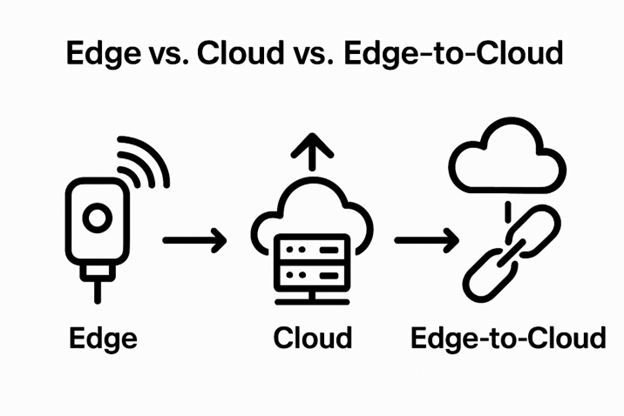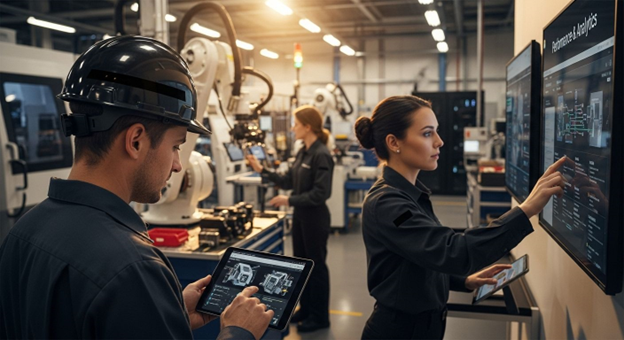
Edge to cloud technology is changing the way companies handle massive amounts of data and make real-time decisions. Most people think making things faster and more efficient means just cranking up server power in the cloud. But processing data at the edge can actually cut network congestion by over 40 percent and improve system performance beyond what centralized cloud alone can achieve. The real surprise is how blending local and cloud computing is quietly creating smarter, more adaptable systems in everything from healthcare to manufacturing.
| Takeaway | Explanation |
|---|---|
| Edge to Cloud Reduces Latency | Processing data closer to its source minimizes delays in data transmission, enhancing system responsiveness. |
| Advances Real-Time Analytics | Organizations can analyze critical data instantly, enabling timely decision-making across various applications. |
| Integrates Security Protocols | Robust security measures are essential to protect distributed networks and sensitive data during transmission. |
| Enables Intelligent Resource Allocation | Dynamic orchestration optimizes where computations occur, balancing workloads between edge devices and cloud infrastructure. |
| Supports Diverse Industry Applications | Industries like healthcare and manufacturing significantly benefit from edge to cloud technology for efficiency and performance. |
Edge to cloud technology represents a transformative computing paradigm that bridges localized data processing with centralized cloud infrastructure. This architectural approach enables organizations to process, analyze, and manage data more efficiently by strategically distributing computational workloads across different computing environments.
The edge to cloud framework emerges from the convergence of two critical computing domains: edge computing and cloud computing. Edge computing focuses on processing data near its source, such as IoT devices, sensors, or local networks, minimizing latency and reducing bandwidth consumption. Cloud computing, in contrast, provides centralized, scalable computational resources accessible through internet connectivity.

In the edge to cloud model, data processing occurs across a spectrum of computing layers, allowing for intelligent decision making and optimized resource utilization. According to IEEE research, this approach enables organizations to:
The edge to cloud ecosystem comprises several critical technological components that work in synchronization. These include edge nodes (local computing devices), communication protocols, data orchestration mechanisms, and cloud backend infrastructure. Each component plays a crucial role in facilitating seamless data transmission, processing, and storage across distributed computing environments.
Below is a table summarizing the core components of edge to cloud architecture along with their roles, as described in the article.
| Component | Description |
|---|---|
| Edge Nodes | Local computing devices (e.g., IoT sensors, smartphones) that collect and process data |
| Communication Protocols | Mechanisms for secure, efficient data transmission between edge devices and the cloud |
| Data Orchestration Mechanisms | Tools that manage workflow, workload allocation, and data synchronization |
| Cloud Backend Infrastructure | Centralized servers where large-scale analytics, long-term storage, and complex tasks run |
| Security Protocols | Measures to protect data integrity and privacy during transfer and processing |
Organizations implementing edge to cloud strategies must carefully design their infrastructure to ensure:
By integrating edge and cloud computing paradigms, businesses can create more intelligent, responsive, and efficient technological ecosystems that adapt to complex computational demands.
This table compares the key features and benefits of edge computing, cloud computing, and the blended edge to cloud model discussed in the article.
| Approach | Main Processing Location | Strengths | Typical Use Cases |
|---|---|---|---|
| Edge Computing | Near data source (on-premises) | Reduces latency, minimizes bandwidth use, enables real-time response | IoT, industrial automation |
| Cloud Computing | Remote, centralized data centers | Scalability, massive storage and analytics, global access | Big data analytics, backups |
| Edge to Cloud | Both edge and cloud combined | Balances fast local processing with scalable cloud analytics, optimizes resources | Healthcare monitoring, smart factories |
As digital transformation accelerates, edge to cloud technology has become a critical infrastructure strategy for organizations seeking competitive advantage. This innovative approach addresses the escalating computational demands driven by emerging technologies like artificial intelligence, Internet of Things (IoT), and real-time data analytics.
Modern businesses face unprecedented challenges in managing massive data volumes and processing complex computational workloads. Edge to cloud technology provides a sophisticated solution by enabling distributed computing capabilities that balance performance, efficiency, and scalability. According to IEEE research, this paradigm supports applications requiring low latency, real-time processing, and adaptive computational resources.
The strategic importance of edge to cloud extends across multiple sectors:
By decentralizing computational processes, edge to cloud architectures dramatically improve system responsiveness and resource utilization. Organizations can now process critical data closer to its source while leveraging centralized cloud infrastructure for complex analytics and long-term storage. Learn more about high-performance computing strategies that complement these technological approaches.
Key performance advantages include:
The convergence of edge and cloud computing represents more than a technological trend. It signifies a fundamental reimagining of how organizations capture, process, and leverage digital information in an increasingly complex technological ecosystem.
Edge to cloud technology operates through a sophisticated, multi-layered architecture that enables intelligent data processing and seamless computational resource allocation across distributed environments. This intricate system transforms how organizations manage and leverage computational capabilities.
The edge to cloud architecture fundamentally revolves around a dynamic data processing continuum. Edge nodes, which are local computing devices like IoT sensors, smartphones, or industrial equipment, initiate the computational process by collecting and performing initial data processing. These devices handle immediate, time-sensitive computations, filtering and preprocessing data before transmission to centralized cloud infrastructure.
According to medical technology research, the architectural workflow typically involves:
Successful edge to cloud implementation depends on robust communication protocols that ensure secure, efficient data transmission. These protocols manage data routing, bandwidth optimization, and computational resource allocation. Intelligent orchestration mechanisms dynamically determine whether computational tasks should be processed locally at the edge or routed to cloud infrastructure based on complexity, latency requirements, and available resources.
Key communication considerations include:
By integrating edge computing’s proximity-based processing with cloud computing’s massive computational power, organizations can create responsive, intelligent systems that adapt to complex computational demands. Explore advanced high-performance computing strategies that complement these architectural approaches.
Edge to cloud technology is transforming industries by providing sophisticated computational solutions that bridge localized data processing with advanced cloud analytics. This innovative approach enables organizations to create more responsive, intelligent systems across multiple sectors.
Medical technology represents one of the most compelling domains for edge to cloud applications. Remote patient monitoring systems leverage edge devices like wearable sensors to collect real-time health data, perform immediate triage assessments, and securely transmit critical information to cloud platforms for comprehensive analysis. According to MITRE research, these systems enable:
Manufacturing environments increasingly rely on edge to cloud architectures to optimize operational efficiency. Smart factories utilize edge nodes embedded in machinery to monitor equipment performance, detect potential failures, and perform predictive maintenance. These localized computational capabilities enable immediate interventions while simultaneously feeding comprehensive data to cloud platforms for long-term strategic analysis. Explore advanced computing strategies for industrial applications.
Key industrial applications include:

By integrating edge computing’s immediate processing capabilities with cloud infrastructure’s analytical power, organizations can create more adaptive, intelligent technological ecosystems that respond dynamically to complex operational challenges.
The landscape of edge to cloud technology continues to evolve rapidly, driven by emerging technological capabilities and complex computational demands. Organizations are witnessing a transformative shift towards more intelligent, adaptive, and secure distributed computing architectures.
Edge AI represents a groundbreaking frontier in distributed computing, enabling intelligent data processing directly at the source. According to research from the Journal of Network and Computer Applications, emerging technologies are focusing on autonomous systems that can:
With increasing computational complexity, cybersecurity becomes paramount in edge to cloud architectures. Emerging strategies are incorporating advanced protection mechanisms like blockchain technology to create more secure, transparent computing environments. Learn about digital transformation strategies for emerging technologies that address these evolving security challenges.
Key security innovations include:
The future of edge to cloud solutions promises a more interconnected, intelligent computational ecosystem that adapts dynamically to organizational needs while maintaining robust security and performance standards.
The complexity and scale explored in “Understanding What is Edge to Cloud Technology” reveal a real challenge for organizations. From navigating distributed computing architectures to overcoming latency and security hurdles, deploying edge to cloud solutions requires more than just technical expertise. You need fast access to scalable, high-performance infrastructure that is ready the moment you are. Through Nodestream, you can bridge the gap between your edge devices and cloud computing ambitions with confidence and speed.
Why wait while your project goals depend on immediate action? Experience enterprise-grade transparency, verified listings, and tailored support for your next edge to cloud deployment. Explore our real-time inventory to discover AI-ready GPUs and HPC servers for any workload. Visit Nodestream and accelerate your edge to cloud transformation today.
Edge to cloud technology is a computing paradigm that integrates edge computing, which processes data close to its source, with cloud computing, which offers centralized data processing and storage. This framework allows for efficient data management and lower latency by distributing computational workloads across different environments.
By decentralizing data processing, edge to cloud technology enhances system responsiveness and resource utilization. It enables immediate data processing at the edge while leveraging the cloud for complex analytics, resulting in reduced network latency and improved computational flexibility.
The key components include edge nodes (local computing devices), communication protocols, data orchestration mechanisms, and cloud backend infrastructure. Together, these elements facilitate secure data transmission, processing, and efficient resource allocation across distributed computing environments.
Real-world applications include remote patient monitoring in healthcare, smart manufacturing for operational efficiency, and autonomous vehicle technologies. These applications benefit from the immediate processing capabilities of edge devices while utilizing cloud resources for advanced analytics and long-term data storage.